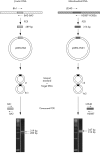Increase of mitochondrial DNA in blood cells of patients with Leber's hereditary optic neuropathy with 11778 mutation
- PMID: 12185132
- PMCID: PMC1771259
- DOI: 10.1136/bjo.86.9.1027
Increase of mitochondrial DNA in blood cells of patients with Leber's hereditary optic neuropathy with 11778 mutation
Abstract
Aims: To investigate the change of mitochondrial DNA (mtDNA) content in Leber's hereditary optic neuropathy (LHON) with 11778 mutation.
Methods: Mitochondrial DNA content in 27 LHON patients with 11778 mutation, 26 asymptomatic maternal relatives, and 23 normal controls was measured using a competitive polymerase chain reaction (PCR) method.
Results: The mean relative content of mtDNA (with respect to the beta actin gene) in LHON patients, asymptomatic maternal relatives, and normal controls was 245.5 (162.3), 238.2 (118.4), and 156.5 (61.6), respectively. There was a statistically significant difference between patients and controls and between relatives and controls. However, no statistically significant difference between patients and unaffected relatives was found. There was no statistically significant difference in the relative content of mtDNA between all males and females carrying 11778 mtDNA mutation
Conclusion: The results suggest that the increase in mtDNA content in LHON patients with 11778 mtDNA mutation may be due to a compensatory effect for respiratory chain defects of mitochondria. However, the increase of mtDNA content is the result rather than the cause of defective mtDNA. It still cannot explain the pathogenesis of LHON.
Figures



Similar articles
-
mtDNA/nDNA ratio in 14484 LHON mitochondrial mutation carriers.J Hum Genet. 2004;49(12):701-705. doi: 10.1007/s10038-004-0209-5. Epub 2004 Nov 16. J Hum Genet. 2004. PMID: 15635488
-
[Rapid genetic screening of Leber's hereditary optic neuropathy with mtDNA G11778A mutation by AS-PCR with whole blood].Zhonghua Yan Ke Za Zhi. 2005 Mar;41(3):243-5. Zhonghua Yan Ke Za Zhi. 2005. PMID: 15840367 Chinese.
-
Leber's hereditary optic neuropathy, intellectual disability and epilepsy presenting with variable penetrance associated to the m.3460G >A mutation and a heteroplasmic expansion of the microsatellite in MTRNR1 gene - case report.BMC Med Genet. 2018 Jul 27;19(1):129. doi: 10.1186/s12881-018-0644-3. BMC Med Genet. 2018. PMID: 30053855 Free PMC article.
-
[The influence of mitochondrial haplogroup on Leber's hereditary optic neuropathy].Zhonghua Yi Xue Yi Chuan Xue Za Zhi. 2008 Feb;25(1):45-9. Zhonghua Yi Xue Yi Chuan Xue Za Zhi. 2008. PMID: 18247303 Review. Chinese.
-
Leber Hereditary Optic Neuropathy: Exemplar of an mtDNA Disease.Handb Exp Pharmacol. 2017;240:339-376. doi: 10.1007/164_2017_2. Handb Exp Pharmacol. 2017. PMID: 28233183 Review.
Cited by
-
Increased relative mitochondrial DNA content in leucocytes of patients with NAION.Br J Ophthalmol. 2006 Jul;90(7):823-5. doi: 10.1136/bjo.2006.090332. Epub 2006 Mar 15. Br J Ophthalmol. 2006. PMID: 16540486 Free PMC article.
-
A Drosophila model for mito-nuclear diseases generated by an incompatible interaction between tRNA and tRNA synthetase.Dis Model Mech. 2015 Aug 1;8(8):843-54. doi: 10.1242/dmm.019323. Epub 2015 May 5. Dis Model Mech. 2015. PMID: 26035388 Free PMC article.
-
The optic nerve: a "mito-window" on mitochondrial neurodegeneration.Mol Cell Neurosci. 2013 Jul;55(100):62-76. doi: 10.1016/j.mcn.2012.08.004. Epub 2012 Aug 15. Mol Cell Neurosci. 2013. PMID: 22960139 Free PMC article. Review.
-
The role of mitochondria in health, ageing, and diseases affecting vision.Br J Ophthalmol. 2006 Jul;90(7):809-10. doi: 10.1136/bjo.2006.091884. Br J Ophthalmol. 2006. PMID: 16782943 Free PMC article.
-
Analysis of nuclear and mitochondrial genes in patients with pseudoexfoliation glaucoma.Mol Vis. 2008 Jan 10;14:29-36. Mol Vis. 2008. PMID: 18246027 Free PMC article.
References
-
- Newman N. Leber hereditary optic neuropathy: new genetic consideration. Arch Neurol 1993;50:540–8. - PubMed
-
- Wallace DC, Brown MD, Lott MT. Mitochondrial DNA variation in human evolution and disease. Gene 1999;23:211–30. - PubMed
-
- Besch D, Wassinger B, Zrenner E, et al. A case of Leber optic neuropathy with a new point mutation in the cytochrome b gene. Ophthalmologe 2000;97:22–6. - PubMed
-
- Chinnery PF, Brown DT, Andrews RM, et al. The mitochondrial ND6 gene is a hot spot for mutations that cause Leber hereditary optic neuropathy. Brain 2001;124:209–18. - PubMed
-
- Johns DR. Genotype-specific phenotypes in Leber optic neuropathy. Clin Neurosci 1994;2:146–50.
Publication types
MeSH terms
Substances
LinkOut - more resources
Full Text Sources
